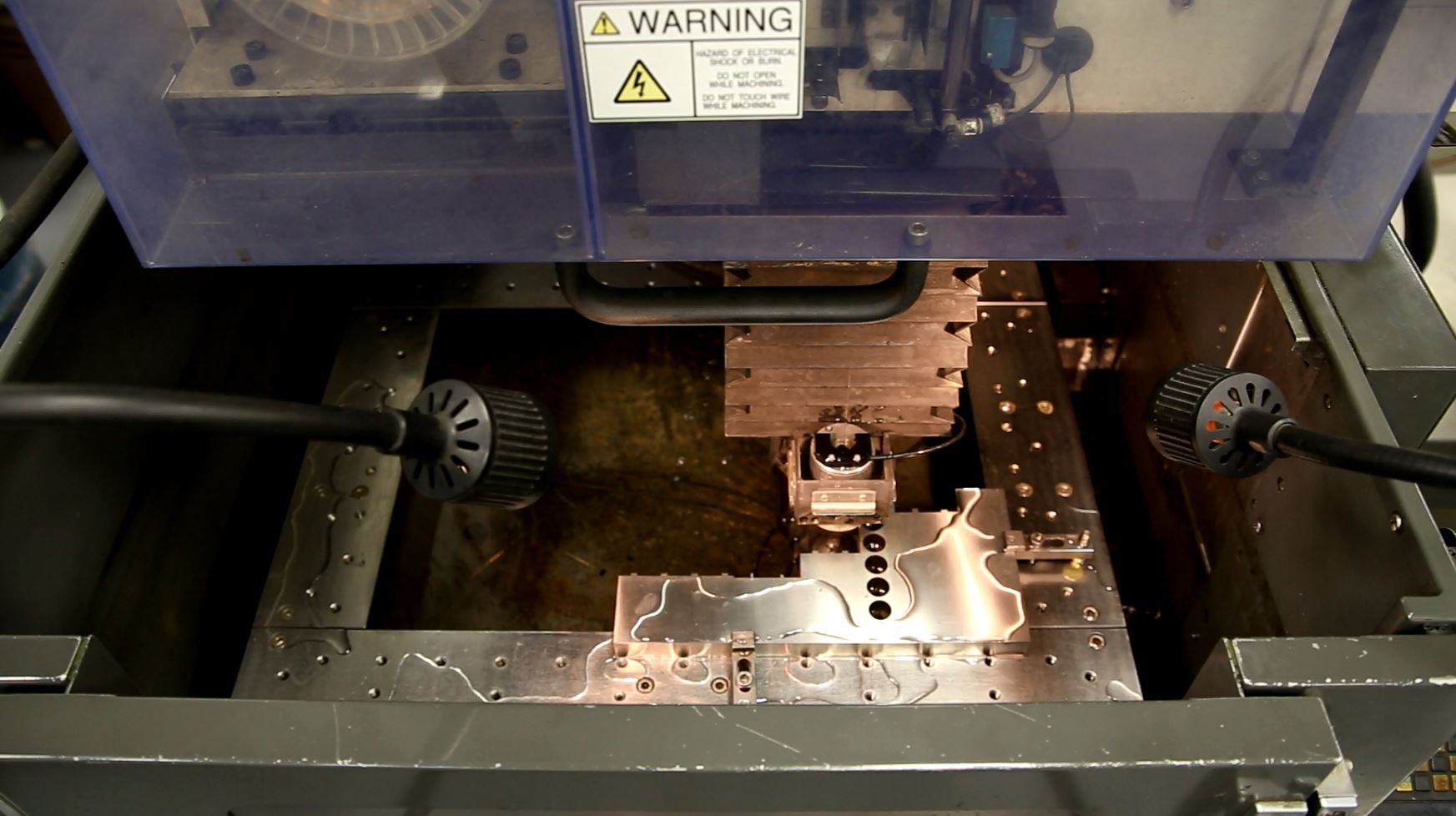EDM (electrical discharge machining) is used as an alternative to conventional CNC machining techniques, particularly for complex shapes, harder materials, and machining of refractory metals. Without touching the material, wire EDM machines can meet mind-bogglingly tight tolerances with precision, including drilling holes for various applications. EDM techniques are often used for precision parts that would be difficult and expensive to manufacture by other means.
How Wire EDM Machines Work
Known by various names like die sinking, spark eroding, spark machining, wire burning, or wire erosion, EDM utilizes electrical discharges to fabricate metal parts. Unlike traditional machining, EDM removes material from a workpiece using recurring current discharges between two electrodes separated by a dielectric liquid. These electrodes, the “tool-electrode” and “workpiece-electrode,” do not make physical contact during the process. Wire EDM machines are ideal for hard, electrically conductive materials that are challenging to machine conventionally.
Wire EDM machines use CNC technology, a dielectric system, and power supply, along with physical equipment that includes a tape unit, wire drive apparatus, work stand, and worktable. Using electricity, wire EDM machines offer extraordinarily high precision when compared to more conventional machining methods. It’s the most efficient approach for machining materials that are good conductors of electricity while allowing for incredible precision when fabricating smaller, more complex components.
Benefits of wire EDM machining include:
- Ability to fabricate metal components at relatively high speeds without touching or affecting the quality of workpieces.
- Achieving high levels of tolerance to around +/- 0.0002 inches (+/- 5.08 micrometers).
- Allowing reliable cutting of cavities, curves, oddly-shaped angles, sharp corners and tapers made externally or internally, among other types of cutting.
- Capabilities for cutting small objects into complex geometries with great accuracy.
- CNC technology incorporated with wire EDM machines allows computerized software and/or robots to cut challenging workpieces while also eliminating burrs and other deformations.
- Consistency in fabricating intricate components, with quick turnarounds and little time needed for setup.
- Cutting fragile workpieces that traditional machining methods would damage.
- Necessitating very little infrastructure and minimal space due to the compactness of wire EDM machines.
- Offering a cost-effective means for precision machining.
- Producing tiny holes accurately at high speeds.
- Reducing the need for cleaning, heat treatments, and polishing as workpieces using EDM technology requires very little or no finishing after machining.
Wire EDM machines have many advantages over more conventional machining technologies. Even when compared to laser cutting, EDM machining produces exceptional results. Though wire EDM machines may cost more initially, they’re more profitable for machine shops than other machining equipment over time.
3 Techniques for Wire EDM Machines
EDM Drilling
As one of the earliest EDM techniques developed, EDM drilling is valuable for various applications like creating scientific and medical equipment, rocket engines, and gas turbine blades. It excels in crafting long, straight, small-bore holes with precise dimensions throughout their depth. EDM drilling can produce holes as small as 0.0015 inch (38.1 micrometers) to any depth with a high aspect ratio.
This technique enables the creation of smooth walls for holes in materials unsuitable for conventional machining, especially for complex geometries. The machined finish within these holes is so precise that bearings can operate smoothly without further processing. Dielectric fluid aids in irrigation, cooling, and debris removal during drilling, functioning similarly to a syringe needle.
Unlike wire EDM machines that use a wire drawn through a workpiece, EDM drilling machines directly push a narrow wire into the material. This method eliminates concerns about tool breakage or bending during drilling. EDM drilling can pierce hard surfaces at various angles, unlike conventional drilling, which requires a perpendicular approach. Sometimes, EDM drilling is utilized before wire EDM machining for certain workpieces.
Sinker Discharge EDM
Referred to as “ram” or “cavity” EDM, sinker discharge machining uses a two-dimensional electrode to shape workpieces. The electrode, which may have a three-dimensional end, clears debris on the Z-axis while machining. The electrode can have any cross-sectional shape and a complex end form without undercuts, machined from copper, graphite, or a mix of both materials. Sinker discharge EDM is commonly used to create molds or dies and achieve detailed features without material stress or the need for extra finishing. This process makes intricate three-dimensional holes, with the electrode mirroring the final workpiece. Unlike other methods, sinker discharge EDM electrodes must be remade for each redesign, typically crafted through CNC milling from easily machinable materials before handling tougher metals.
Wire EDM
Often known as wire-cutting EDM, this method uses a wire to erode material by creating sparks between the workpiece and the wire. The wire EDM technique initially focused on two-dimensional cuts on hard materials along the x and y axes, with the z-axis representing thickness. An EDM wire machine utilizes a straight wire as an electrode to cut through the workpiece. Different wires like zinc-diffused copper or brass are used with diamond or sapphire guides as electrodes. The process results in varied machined properties. Wire EDM machines have evolved to include wire rollers for controlled cuts at an angle along the z-axis, with modern 5-axis wire EDM machines capable of cutting through hard alloys in a single action. This technique is commonly used for creating die and punch sets and extrusion tools.
The Staub Difference for Wire EDM Machining
Staub Precision Machine Inc. provides EDM solutions for our customers’ needs, including work done by sinker discharge and wire EDM machines. Staub offers in-house EDM services that can meet the most demanding tolerances for precision parts and other workpieces. To learn more about Staub’s EDM and other machining capabilities, contact one of our friendly representatives today.



